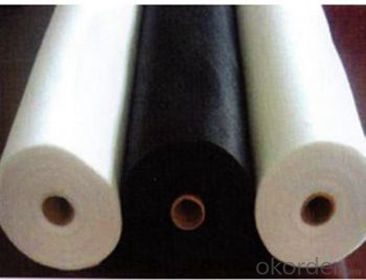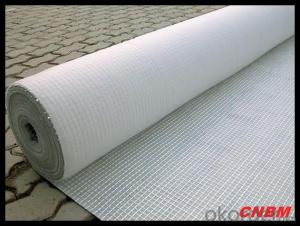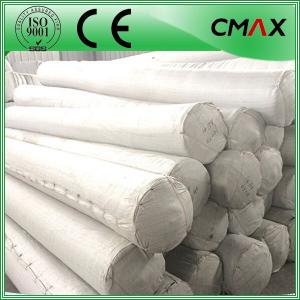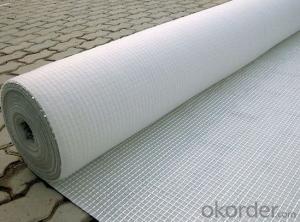Non-Woven Geotextile Needle Punched PP for Reinforcement and Drainage
- Loading Port:
- China main port
- Payment Terms:
- TT OR LC
- Min Order Qty:
- 4000 g/m²
- Supply Capability:
- 1000000 g/m²/month
OKorder Service Pledge
OKorder Financial Service
You Might Also Like
Specification

Filtration:
It can be the filtration layer of the dykes, river canal, seacoast, concrete slope, retaining walls. At the same time of preventing the clay granule from passing, it allows the water and the gas pass through freely.
Separation:
The isolation of the railway dregs and the roadbed, roadbed and the soft base, surface of the airdrome and parking lot and the groundsill, different dam materials. It isolates the soil and the gravel of two kinds different granule pathway from the groundsill or other buildings.
Reinforcement:
The highway, railway, soil-stone dam, breakwater, airport, backfill soil of retaining wall, slope protection, etc in which distributes the earth stress, prevents the side-displacement of the earth body and improves the earthbody stability. 
1. short fiber needle punched nonwoven geotextiles (heat set or not) Pet short fiber
2. different color nonwoven geotextile
3. The product has the property of anti-aging, high strength, good flexibility and permeability, filtration, isolation and easy construction
4. It is widely used in areas of the railway, highway, sport venue,dyke,water project construction, tunnel,sea beach,inning,environment protection and so on. It can also used in the reinforcement, separation,filtration,drainage ect.
FAQ:
Q: What kind of payments does jenor support?
A: T/T, L/C, Cash are accepted.
Q: Do you charge for the samples?
A: Accordeing to our company policy, the samples are free, we only charge the freight fee. And we will return the freight fee during the next order.
Q: Can you produce according to customers' design?
A: Sure, we are professional manufacturer, OEM and ODM are both welcome.
Q: Do you have other products?
A: Yes, please check the pictures:
- Q: Is the filament geotextile the same as the tensile strength of other acupuncture nonwoven fabrics?
- 1, polyester filament acupuncture non-woven geotextile pet.15-6-300, is the national standard filament geotextile, the material for the polyester polyester (PET), the unit area of the quality of 300g / ㎡, the breaking strength of 15KN / m in line with GB GB / T-2008 standard 300g / ㎡ filament geotextile requirements. Polyester filament acupuncture non-woven geotextile pet.15-6-300 product width of 6m, 6m wide polyester filament geotextile is a more conventional products, manufacturers can directly produce 6m wide polyester filament Geotextile. 1. First geotextile polyester staple fiber geotextile (PET) and polyester filament geotextile two. The physical tensile strength of the two geotextiles is different. 2. Polyester staple geotextile according to the national standard GB / T-2008 standard implementation, 400g GB polyester staple geotextile physical tensile strength ≥ 12.5KN. 3. Polyester filament geotextile in accordance with the national standard GB / T-2008 standard implementation, 400g GB polyester filament geotextile physical tensile strength ≥ 20KN. 4.400g GB polyester staple geotextile longitudinal and horizontal tear strength ≥ 0.33KN, 400g GB polyester filament geotextile longitudinal and horizontal tear strength ≥ 0.56KN.
- Q: The properties of woven geotextiles
- Product features: 1, with a reinforcement function: to stabilize the project in the course of prolonged use of the transfer occurred, and can be the role of the soil in the local stress transmission or assigned to a larger area. 2, with the role of separation: woven geotextile with different geotechnical structure to form a stable interface, in accordance with the requirements to play their own characteristics and the overall role. 3, the role of drainage filter: allow moisture to block the loss of sand particles, in the drainage of geotextiles on the poor water in the soil can play the water along the geotextile quickly discharged the purpose. 4, the geotextile and geomembrane used in two different pressures between the material can play a role in tension diaphragm. 5, with a block function: the geotextile placed in the flow of liquid with suspended particles in the channel to organize fine mud particles, and allow the liquid through the function. 6, play the role of cushion mat: the geotextile placed on the slope can prevent the soil particles due to the erosion of rain and the loss or planting turf.
- Q: What are the different geotextile filtration testing methods?
- There are several different geotextile filtration testing methods, including the gradient ratio test, the constant head test, the falling head test, and the sand column test. These tests are conducted to evaluate the ability of geotextiles to filter out fine particles from water or other fluids, and to assess their performance in various filtration applications.
- Q: Can geotextiles be used in subsurface drainage applications?
- Yes, geotextiles can be used in subsurface drainage applications. Geotextiles are often used as a filter or separator in drainage systems to prevent soil erosion and clogging of drainage pipes. They allow water to pass through while retaining soil particles, thus enhancing the performance and longevity of subsurface drainage systems.
- Q: Under what circumstances drainage pipes need additional geotextiles
- Infiltration of water under the circumstances, geotextile play a filtering effect, Huazhi geotextile material manufacturers
- Q: How do geotextiles help with reinforcement of steep slopes?
- Geotextiles are used in the reinforcement of steep slopes by providing stability and preventing soil erosion. They act as a barrier between the soil layers, distributing the weight and stress evenly across the slope. This helps to increase the shear strength of the soil, reducing the likelihood of slope failure. Additionally, geotextiles allow water to drain through them, reducing the buildup of excess moisture and providing better drainage, which further helps in preventing erosion and maintaining the stability of the slope.
- Q: What is the place of attention for the laying of geotextiles?
- (1) the use of the use of buried type: cover the thickness should not be less than 30cm (2) refurbishment system should be: cushion, impermeable layer, transition layer, protective layer composition. (3) soil to be solid, to avoid uneven subsidence, cracks, anti-seepage within the turf, root to clear. And the surface of the membrane with a small particle size of sand or clay as a protective layer. (4) laying the geomembrane do not pull too tight, both ends of the soil into the corrugated part of the soil is better, especially with the rigid material anchoring, should leave a certain amount of expansion and contraction. (5) construction, should avoid stones,
- Q: Precautions for Polyester Filament Geotextiles
- Geotextile storage to meet the following requirements: the Treasury clean no debris, no chemical corrosion; not sun, tarnished; not weight, not scratch, to prevent violent collision; away from the hot source; dry and cool warehouse; There is a need for fire tools, fire hydrants, fire extinguishers and so on. Geotextile transport, loading and unloading requirements: can not be mixed with sharp items; hoisting with flexible rope; can not use steel wire rope directly hoisting; not with sticks, iron bars and other hardware auxiliary top loading; Stress dispersion measures, to avoid tightly tightened with a rope.
- Q: What are the limitations of using geotextiles?
- Some limitations of using geotextiles include their susceptibility to clogging, reduced effectiveness in high-flow conditions, potential for damage during installation or handling, limited ability to withstand heavy loads, and relatively short lifespan compared to other geosynthetic materials. Additionally, geotextiles may not be suitable for all soil types or environmental conditions, and their performance can vary depending on factors such as installation technique and maintenance.
- Q: What are the primary applications of geotextiles?
- Geotextiles have various primary applications that include erosion control, soil stabilization, drainage systems, road construction, and filtration.
Send your message to us
Non-Woven Geotextile Needle Punched PP for Reinforcement and Drainage
- Loading Port:
- China main port
- Payment Terms:
- TT OR LC
- Min Order Qty:
- 4000 g/m²
- Supply Capability:
- 1000000 g/m²/month
OKorder Service Pledge
OKorder Financial Service
Similar products
Hot products
Hot Searches
Related keywords





























